
The Yorkville Clock at 1501 3rd Avenue and East 85th Street has been here since 1898 — lasting an entire century and parts of two others. Like many other sidewalk clocks it originally promoted a jeweler’s, in this case The Adolph Stern store. It was manufactured by the E. Howard Clock Company, and was designated a NYC landmark by the Landmarks Preservation Commission in 1981. That did not prevent its temporary removal, however — in 1985, a city employee mistakenly sold the clock as surplus to a Long Island collector. The Koch administration tracked it down and by 1989 it was back in service, this time next to a McDonalds. To celebrate its first century in service, in 1999 the pocketwatch-inspired clock received a complete overhaul and has kept perfect time ever since.
Note that as with most clocks using Roman numerals, “4” is rendered as “IIII” instead of the “IV” used in original Roman script. Can anyone tell me how this tradition got started?
The most plausible thing I’ve heard is that early clockmakers didn’t want people to mix up the IV and VI, so they substituted the IIII.
Check out the ForgottenBook, take a look at the gift shop, and as always, “comment…as you see fit.”
2/12/21


6 comments
I remember being taught that IIII was an alternate to IV
Building at left 185 East 85th, is where “The Jeffersons” moved on up to.
I’m trying to remember other similar clocks still present–Steinway Street, Astoria and NYC Bway near 23rd street are the ony two I can come up with.
Manhattan Avenue, between Meserole and Norman Avenues, in Greenpoint. It is the only surviving cast iron clock in Brooklyn. This clock was also made by the E. Howard Clock Co. and was installed in front of Bomelstein Jewelers, 753 Manhattan Ave. In 2001, t was moved from it’s original location to in front of 733 Manhattan Avenue. The clock was almost destroyed in 2002 after being hit by a truck. It was restored to working condition by E. Howard in 2017; however, the original bezel which read “BOMELSTEIN” was replaced with one reading “GREENPOINT”.
Alternate title for this post:
“Four Play on Third”.
One explanation I’ve heard is that it has to do with the casting of individual letters for clock faces like this one. If you do it that way, you have 20 I’s, 4 V’s and 4 X’s. In other words, each letter can be cast in blocks of four (5 x 4 Is and 1 x 1 Vs and Xs). Cecil Adams’ Straight Dope column once directly addressed this question, but didn’t come to any firm conclusion. https://www.straightdope.com/21341605/why-do-clocks-with-roman-numerals-use-iiii-instead-of-iv